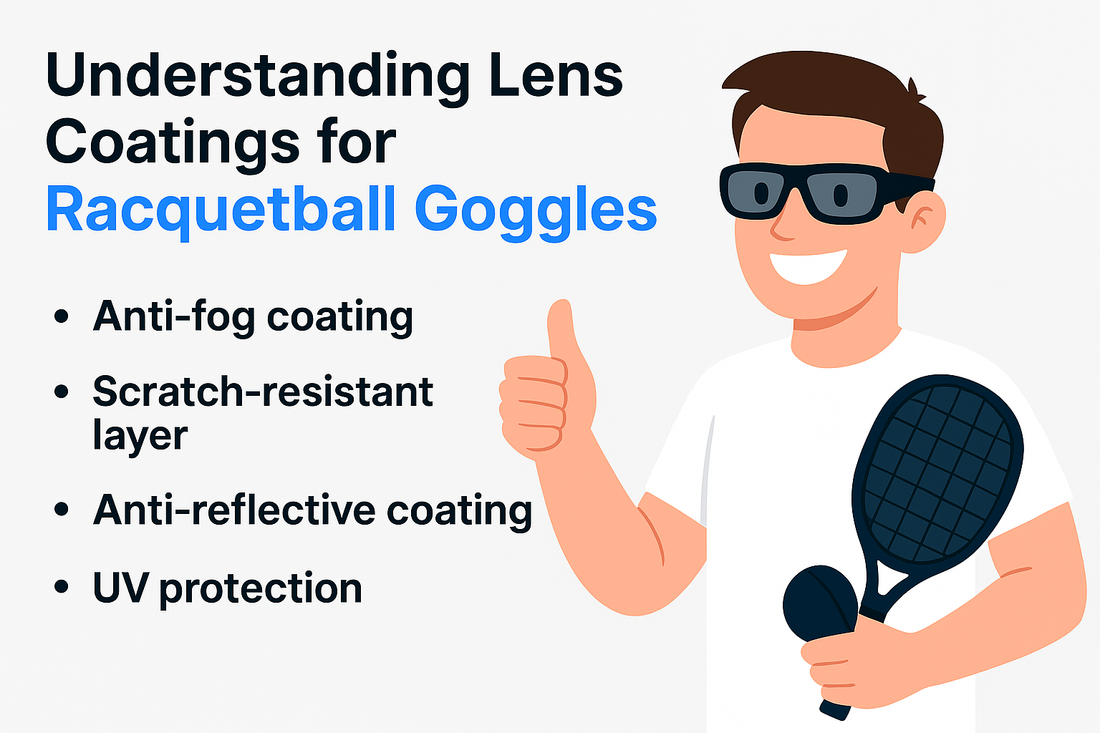
Understanding Lens Coatings for Racquetball Goggles
Fast serves, quick pivots, sweat, and indoor lighting put your vision to the test on the racquetball court. The right lens coatings turn standard goggles into high-performance eyewear that stays clear, resists damage, and helps you focus on every shot. If you have ever wiped your lenses mid-rally or battled glare under bright lights, this guide is for you. 🎾
Why lens coatings matter for racquetball
Racquetball is played at high speed in enclosed courts, where temperature swings and humidity can fog lenses fast. Ball impact, wall contact, and frequent cleaning can scratch naked lenses over time. Bright overhead fixtures also create glare and ghosting that distracts your eyes. A thoughtful combination of coatings improves clarity, comfort, and durability while keeping your protective eyewear game-ready.
Key coatings explained 🛡️
Anti-fog coating
Anti-fog is the MVP for indoor racquet sports. It helps moisture spread evenly across the lens surface so you see clearly even when you heat up. Look for long-lasting formulas that withstand repeated cleanings. 🌫️
Scratch-resistant hard coat
All polycarbonate lenses benefit from a quality hard coat. It reduces micro-abrasions from court dust, towel wipes, and gear bags. While no lens is truly scratch-proof, a good hard coat can extend lens life significantly.
Anti-reflective (AR) coating
AR reduces glare from overhead LEDs and polished floors, improving contrast and depth perception. It is especially helpful for tracking a fast ball and reading spin. Bonus: AR also cuts distracting reflections on the lens surfaces for cleaner sight lines.
UV protection
If you ever play outdoors or near windows, full-spectrum UV defense is a must. Many impact-resistant lenses already block most UV, but confirm you are getting complete protection. Your eyes will thank you later. ✨
Hydrophobic and oleophobic layers
These smudge-fighting coatings repel sweat, oils, and water, so lenses clean faster and stay clearer between points. They also reduce streaking after quick towel wipes during a timeout.
Mirror or flash coatings
Mirror finishes look sharp and can cut brightness for outdoor play. Indoors, a light flash can help in very bright facilities, but heavy mirrors are usually more useful outside. If you play both, consider a versatile setup.
Photochromic lenses
Photochromic lenses adapt to changing light. They are clutch if you split time between indoor courts and sunny outdoor practice. Indoors they remain relatively clear, then darken under UV outside.
Choosing the right combo for your court
- Indoor-only players: Prioritize anti-fog, hard coat, and AR. Add hydrophobic layers if sweat is a frequent issue.
- Indoor and outdoor mix: Anti-fog plus photochromic, hard coat, and AR for versatility across environments.
- Bright facilities: Anti-fog and AR first, then consider a light flash mirror if glare is persistent.
- Budget-minded: Anti-fog and hard coat deliver the biggest impact per dollar, with AR next in line.
Fit and ventilation still matter
Coatings do heavy lifting, but airflow helps them perform. A snug yet ventilated frame reduces fog triggers. Make sure straps sit flat, the nose bridge feels secure, and the lens shape gives you wide peripheral vision for off-the-wall shots.
Care tips for longer-lasting clarity
- Rinse off court dust with clean water before wiping to avoid micro-scratches.
- Use a lens-safe spray and a microfiber cloth, not your shirt.
- Air-dry after cleaning to protect anti-fog layers.
- Store in a hard case to prevent abrasion in your gym bag.
Looking for the right eyewear? Here are our top picks based on today’s article:
Based on today’s topic, here are a few of our top picks you might love:
- Bruno Sports Glasses in Black and Blue
- Tory Sports Glasses in White and Pink
- Steph Sports Glasses in Black and Blue
FAQs
How do anti-fog coatings work on racquetball goggles?
They spread condensation into a thin, invisible layer so your view stays clear instead of forming droplets that blur vision.
What coatings are most important for indoor courts?
Start with anti-fog and a scratch-resistant hard coat, then add anti-reflective to cut glare from overhead lights.
Can I combine anti-fog with photochromic lenses?
Yes. Many photochromic lenses accept anti-fog and AR, creating a flexible setup for indoor and outdoor play.
Do coatings wear off over time?
They can diminish with harsh cleaners and rough wiping. Use lens-safe solutions and microfiber cloths to extend life.
Why am I still getting fog with anti-fog lenses?
Fit and airflow may be the culprit. Adjust straps, improve ventilation, and keep lenses clean for best performance. 🧼



